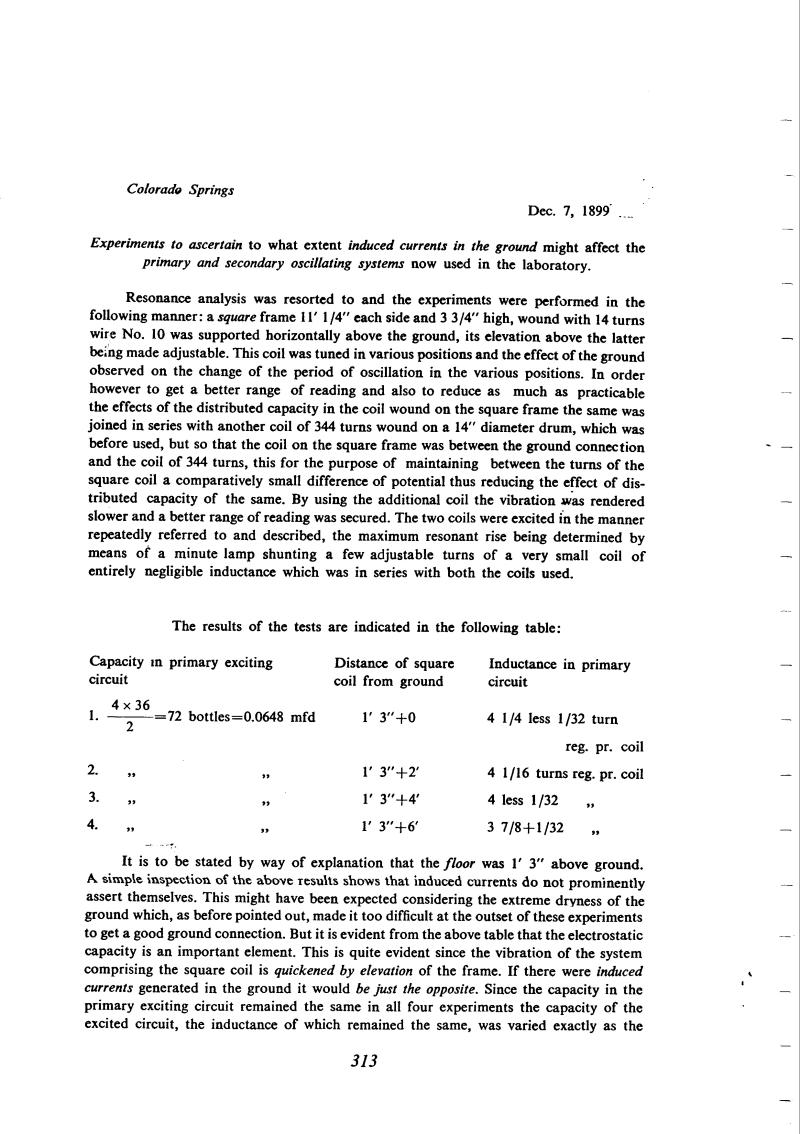
Nikola Tesla Books
Colorado Springs
Dec. 7, 1899
Experiments to ascertain to what extent induced currents in the ground might affect the primary and secondary oscillating systems now used in the laboratory.
Resonance analysis was resorted to and the experiments were performed in the following manner: a square frame 11' 1/4" each side and 3 3/4" high, wound with 14 turns wire No. 10 was supported horizontally above the ground, its elevation above the latter being made adjustable. This coil was tuned in various positions and the effect of the ground observed on the change of the period of oscillation in the various positions. In order however to get a better range of reading and also to reduce as much as practicable the effects of the distributed capacity in the coil wound on the square frame the same was joined in series with another coil of 344 turns wound on a 14" diameter drum, which was before used, but so that the coil on the square frame was between the ground connection and the coil of 344 turns, this for the purpose of maintaining between the turns of the square coil a comparatively small difference of potential thus reducing the effect of distributed capacity of the same. By using the additional coil the vibration was rendered slower and a better range of reading was secured. The two coils were excited in the manner repeatedly referred to and described, the maximum resonant rise being determined by means of a minute lamp shunting a few adjustable turns of a very small coil of entirely negligible inductance which was in series with both the coils used.
The results of the tests are indicated in the following table:
| Capacity in primary exciting circuit | Distance of square coil from ground | Inductance in primary circuit |
|---|---|---|
| 1. $! {{4 \times 36} \over 2} $! = 72 bottles = 0.0648 mfd | 1' 3" + 0 | 4 1/4 less 1/32 turn reg. pr. coil |
| 2. " " | 1' 3" + 2' | 4 1/16 turns reg. pr. coil |
| 3. " " | 1' 3" + 4' | 4 less 1/32 " |
| 4. " " | 1' 3" + 6' | 3 7/8 + 1/32 " |
It is to be stated by way of explanation that the floor was 1' 3" above ground. A simple inspection of the above results shows that induced currents do not prominently assert themselves. This might have been expected considering the extreme dryness of the ground which, as before pointed out, made it too difficult at the outset of these experiments to get a good ground connection. But it is evident from the above table that the electrostatic capacity is an important element. This is quite evident since the vibration of the system comprising the square coil is quickened by elevation of the frame. If there were induced currents generated in the ground it would be just the opposite. Since the capacity in the primary exciting circuit remained the same in all four experiments the capacity of the excited circuit, the inductance of which remained the same, was varied exactly as the
313
December 7-10
Tesla wants to determine the influence of the ground conductor, on the resonance transformer of the oscillator. He performs the measurements on a circuit which is made in the shape of a rectangular frame and its position could be changed in relation to the ground surface. The rectangular frame is wound with 14 turns and connected in series with the coil of 344 turns. One terminal of the coil frame is grounded. He does not give complete information how these coils are connected with the oscillator. He determines the oscillator frequency change when the coil frame is at various elevations above the ground.
He draws the conclusion that the resonant frequency of the tested circuit is increased with the increased elevation of the rectangular coil. On the basis of that he draws the conclusion that: a) The ground does not act as a good conductor (coil in the vicinity of a conductive plane has smaller inductance due to induced currents); b) The capacitance of the coil towards the ground is a significant factor. The conclusions Tesla develops on Dec. 8 and 9 are correct, because it is a question of relative determination of the values, even if there would be a secondary influence which does not allow secure oscillator frequency determination.
On Dec. 9 Tesla attempted to calculate the coil self-capacitance in the tested circuit as per previously described method (please see June 28), but he very soon ended the discussion without giving a complete answer to the problem as a whole.

